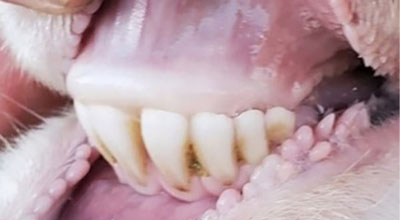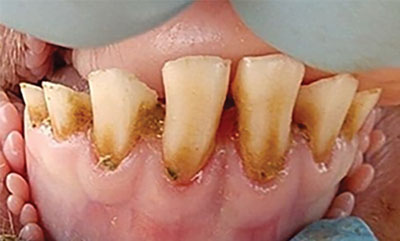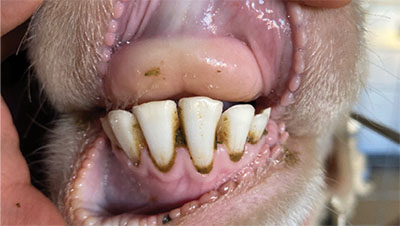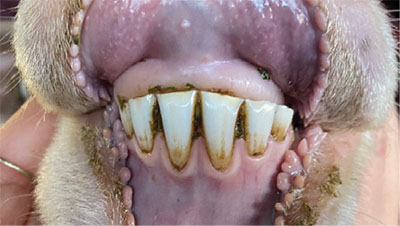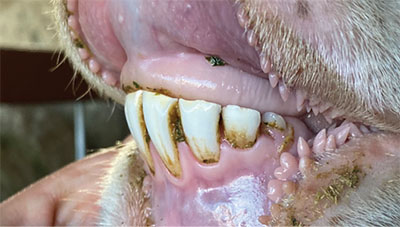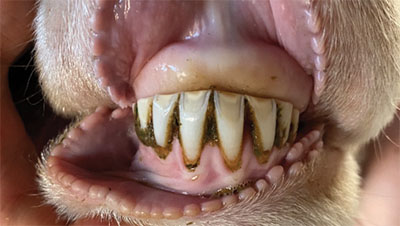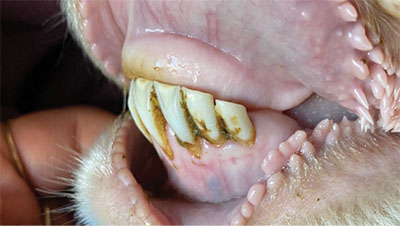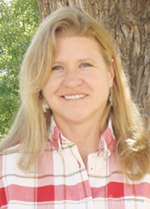Guide B-412
Sarah Pitassi, Jennifer A. Hernandez Gifford, Craig Gifford, and Marcy Ward
College of Agricultural, Consumer and Environmental Sciences, New Mexico State University
Authors: Respectively, former Graduate Student, Department of Animal and Range Sciences (ARS); Associate Professor, ARS; Extension Beef Cattle Specialist, Department of Extension Animal Sciences and Natural Resources (EASNR); and Extension Livestock Specialist, EASNR, New Mexico State University. (Print Friendly PDF)
Knowing how to determine a sheep’s age using its teeth can help with culling and breeding decisions and surveys of overall health. Ruminants lack upper incisors—a unique feature of their dental anatomy—and instead have a dental pad. Small ruminants, like sheep, have three pairs of lower incisors and one pair of canine teeth, which are often referred to as a fourth or corner incisor, as well as six pairs of upper and lower molars toward the back of the mouth. The lower row of eight incisors is designed to clip grasses and forbs, and the molars are designed to masticate (chew) forage.
Permanent tooth eruption in sheep is a good indicator for estimating the age of the animal. Lambs are generally born without teeth, but soon deciduous incisors begin to erupt over the course of several weeks. These deciduous incisors are commonly referred to as milk teeth (Figure 1). Deciduous teeth are temporary teeth that young animals will have until their permanent teeth start to replace them. Determining the age of a sheep based on tooth eruption is done by evaluating the incisors and corner teeth (Table 1).
Figures 1A and 1B. Front (A) and side (B) views of deciduous teeth (milk teeth) of a 2-month-old lamb.
|
Table 1. Ages for Permanent Teeth Presentation for Sheep |
|
|
Permanent Teeth |
Age of the Animal1 |
|
Incisor set 1 |
1 year |
|
Incisor set 2 |
2 years |
|
Incisor set 3 |
3 years |
|
Incisor set 4 |
4 years |
|
1Ages for eruption of permanent teeth can vary by 6 months. |
|
Each year, two milk teeth are replaced in a specific manner, thus allowing for a method to accurately determine the age of the animal. The actual timing of tooth replacement will vary due to breed, nutrition, and environmental factors. At 1 to 1.5 years of age, the two front milk teeth are replaced by the first set of permanent incisors (Figure 2). This replacement of milk teeth continues annually such that at age two, the next two milk teeth are replaced by a second set of permanent incisors (Figure 3), and four permanent incisors are now present. By about age three, a third set of incisors will erupt, and the animal will have six permanent incisors (Figure 4). By the time the animal has reached four years of age, the last set of permanent incisors will be present (Figure 5). Sheep with all their adult teeth are referred to as a solid mouth (Figure 6), and after this point it is difficult to identify age (Ridler and West, 2010). However, normal wear of teeth can be used as an indicator when aging sheep past age four.
Figures 2A and 2B. Front (A) and side (B) views of the first set of permanent incisors of a 1-year-old ewe.
Figures 3A and 3B. Front (A) and side (B) views of the second set of permanent incisors of a 2-year-old ewe.
Figures 4A and 4B. Front (A) and side (B) views of the third set of permanent incisors of a 3-year-old ewe.
Figures 5A and 5B. Front (A) and side (B) views of the fourth set of permanent incisors of a 4-year-old ewe. Note the wear that is beginning to appear on the teeth.
Figures 6A and 6B. Front (A) and side (B) views of a solid mouth of a 7-year-old ewe demonstrating normal tooth wear and spread.
As the animal ages, the loss of incisor length can become a problem that leads to poor performance as a result of inadequate nutrition (Ridler and West, 2010) due to the reduced ability to gather and clip forages and poor mastication. Poor performance caused by inadequate nutrition includes weight loss and reduced milk and fleece production (McGregor, 2011). Structural loss of incisors may occur more readily in pastures with sandy soil where the teeth become worn due to constantly picking up the soil while grazing. Mouth age identification is an important tool when making culling decisions on breeding females. Worn teeth can have negative impacts on grazing efficiency, body condition score, and ultimately the support of pregnancy. Overall, utilizing this age identification tool can positively impact herd health and can help with making decisions about breeding and culling.
Literature Cited
McGregor, B.A. 2011, February. Incisor development, wear and loss in sheep and their impact on ewe production, longevity and economics: A review. Small Ruminant Research, 95, 79–87. https://doi.org/10.1016/j.smallrumres.2010.11.012
Ridler, A.L., and D.M. West. 2010, August. Examination of teeth in sheep health management. Small Ruminant Research, 92, 92–95. https://doi.org/10.1016/j.smallrumres.2010.04.014
For Further Reading
B-127: Sheep and Goat Vaccine and Health Management Schedule
https://pubs.nmsu.edu/_b/B127/index.html
CR-684: Sheep Breeds Best Suited for Arid Climates
https://pubs.nmsu.edu/_circulars/CR684/index.html
CR-703: Sheep Production: Birth to Weaning
https://pubs.nmsu.edu/_circulars/CR703/index.html
Marcy Ward is the Extension Livestock Specialist at NMSU. She received her B.S. and M.S. in animal science from Colorado State University and NMSU, respectively, and her Ph.D. in ruminant nutrition from North Dakota State University. She was most recently the Beef Program Director at Colby Community College in Colby, KS.
To find more resources for your business, home, or family, visit the College of Agricultural, Consumer and Environmental Sciences on the World Wide Web at pubs.nmsu.edu
Contents of publications may be freely reproduced for educational purposes. All other rights reserved. For permission to use the publications for other purposes, contact pubs@nmsu.edu or the authors listed on the publication.
New Mexico State University is an equal opportunity/ affirmative action employer and educator. NMSU and the U.S. Department of Agriculture cooperating
December 2022 Las Cruces, NM



